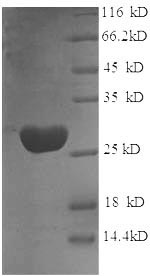Purity
Greater than 90% as determined by SDS-PAGE.
Alternative Names
Gstp1; Glutathione S-transferase P; EC 2.5.1.18; Chain 7; GST 7-7; GST class-pi
Species
Rattus norvegicus (Rat)
Expression Region
2-210aa
Target Protein Sequence
PPYTIVYFPVRGRCEATRMLLADQGQSWKEEVVTIDVWLQGSLKSTCLYGQLPKFEDGDLTLYQSNAILRHLGRSLGLYGKDQKEAALVDMVNDGVEDLRCKYGTLIYTNYENGKDDYVKALPGHLKPFETLLSQNQGGKAFIVGNQISFADYNLLDLLLVHQVLAPGCLDNFPLLSAYVARLSARPKIKAFLSSPDHLNRPINGNGKQ
Note: The complete sequence including tag
sequence, target protein sequence and linker sequence could be provided upon request.
Protein Length
Full Length of Mature Protein
Tag Info
N-terminal 6xHis-tagged
Form
Liquid or Lyophilized powder
Note: We will preferentially ship the format that
we have in stock, however, if you have any special requirement for the format, please remark your
requirement when placing the order, we will prepare according to your demand.
Buffer
If the delivery form is liquid, the default storage buffer is Tris/PBS-based buffer, 5%-50% glycerol.
Note: If you have any special requirement for the
glycerol content, please remark when you place the order.
If the delivery form is lyophilized powder, the buffer before lyophilization is Tris/PBS-based buffer,
6% Trehalose, pH 8.0.
Reconstitution
We recommend that this vial be briefly centrifuged prior to opening to bring the contents to the bottom. Please reconstitute protein in deionized sterile water to a concentration of 0.1-1.0 mg/mL.We recommend to add 5-50% of glycerol (final concentration) and aliquot for long-term storage at -20°C/-80°C. Our default final concentration of glycerol is 50%. Customers could use it as reference.
Storage Condition
Store at -20°C/-80°C upon receipt, aliquoting is necessary for mutiple use. Avoid repeated freeze-thaw
cycles.
Shelf Life
The shelf life is related to many factors, storage state, buffer ingredients, storage temperature
and the stability of the protein itself.
Generally, the shelf life of liquid form is 6 months at -20°C/-80°C. The shelf life of lyophilized
form is 12 months at -20°C/-80°C.
Lead Time
3-7 business days
Notes
Repeated freezing and thawing is not recommended. Store working aliquots at 4°C for up to one week.
Datasheet & COA
Please contact us to get it.
Description
We are proud to introduce the Recombinant Rat Glutathione S-transferase P, a vital element in your molecular research. This protein, also known as Chain 7, GST 7-7, or GST class-pi, is encoded by the 'Gstp1' gene in the Rat species. Its multifunctional properties make it essential to an array of physiological processes, including protection against oxidative stress.
Produced in E.coli, our product includes the full length of the mature protein, extending from amino acid 2 to 210. The inclusion of an N-terminal 6xHis tag aids in its easy detection and purification. We ensure that this product is of high quality, having a purity level greater than 90%, as determined by SDS-PAGE. You can select either a liquid form or a lyophilized powder, according to your research needs. With our Recombinant Rat Gstp1, you can confidently proceed with your experiments, knowing you're equipped with reliable reagents.






